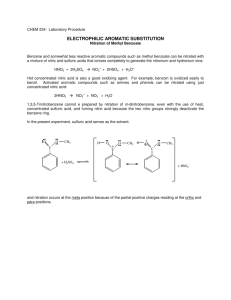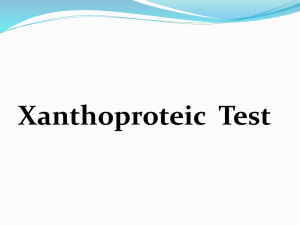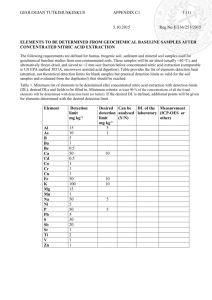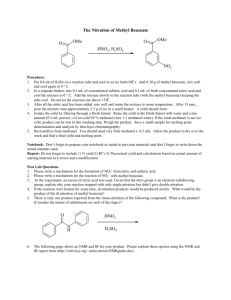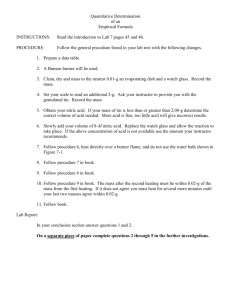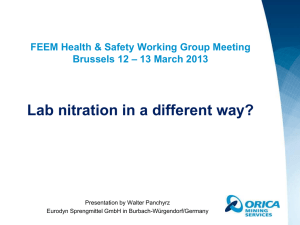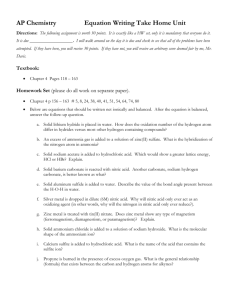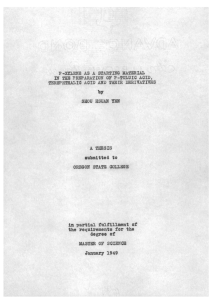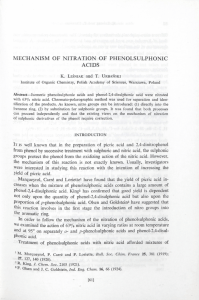On the Mechanism of Nitration with Dilute Nitric Acid
advertisement
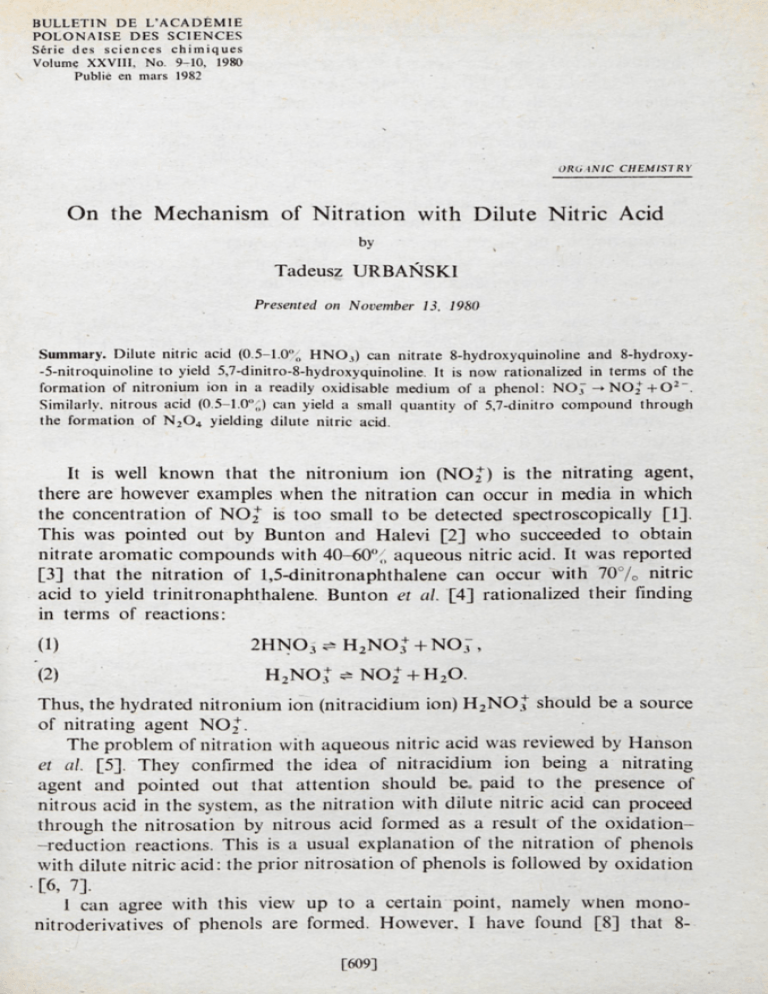
BULLETIN DE L'ACADEMIE POLONAISE DES SCIENCES S é r i e des s c i e n c e s c h i m i q u e s Volume X X V I I I . No. 9-10, 1980 Publie en mars 1982 ORG INIC CHEMISTRY O n the Mechanism of Nitration with Dilute Nitric Acid by Tadeusz URBAŃSKI Presented on November 13. 1980 Summary. Dilute nitric acid (0.5-1.0% H N O , ) can nitrate 8-hydroxyquinoline and 8-hydroxy-5-nitroquinoline to yield 5,7-dinitro-8-hydroxyquinoline. It is now rationalized in terms of the formation of nitronium ion in a readily oxidisable medium of a phenol: N O J - » N 0 +0 ~. Similarly, nitrous acid (0.5-1.0",,) can yield a small quantity of 5,7-dinitro compound Ihrough the formation of N 0 yielding dilute nitric acid. + 2 2 2 4 It is well known that the nitronium ion ( N 0 ) is the nitrating agent, there are however examples when the nitration can occur in media in which the concentration of N 0 is too small to be detected spectroscopically [1]. This was pointed out by Bunton and Halevi [2] who succeeded to obtain nitrate aromatic compounds with 40-60",, aqueous nitric acid. It was reported [3] that the nitration of 1,5-dinitronaphthalene can occur with 70% nitric acid to yield trinitronaphthalene. Bunton ei al. [4] rationalized their finding in terms of reactions: 2 2 (1) 2HN0 ^H NO.t +NOJ, 3 (2) 2 H NO.t * N 0 2 + 2 + H 0. 2 Thus, the hydrated nitronium ion (nitracidium ion) H N O t should be a source of nitrating agent N 0 . The problem of nitration with aqueous nitric acid was reviewed by Hanson et al. [5]. They confirmed the idea of nitracidium ion being a nitrating agent and pointed out that attention should be. paid to the presence of nitrous acid in the system, as the nitration with dilute nitric acid can proceed through the nitrosation by nitrous acid formed as a result of the oxidation-reduction reactions. This is a usual explanation of the nitration of phenols with dilute nitric acid: the prior nitrosation of phenols is followed by oxidation • [6, 7]. I can agree with this view up to a certain point, namely when mononit roderivatives of phenols are formed. However. 1 have found [8] that 82 2 [609] T. Urbański 610 ь -hydroxyquinoline can be converted to 5,7-dinitrocompound by boiling with 8% nitric acid, and also [9] that the same result, on prolonged boiling, can be achieved by highly dilute 0.5-1.0% nitric acid. The formation to dinitro compound could not be explained in terms of nitrosation. It should involve a simultaneous nitrosation in two places—an unknown reaction. Another still stronger point is the experimental fact that 8-hydroxy-5-nitroquinoline can be nitrated by refluxing for 15 min with 0.5-1.0% nitric acid to yield (ca. 50%) 5,7-dinitro-8-hydroxyquinoline [9]. It is well known that nitrophenols cannot be nitrosated with nitrous acid and subsequently the introduction to the nitro group in position 7 cannot occur through nitro­ sation. Nevertheless, the reaction with 0.5-1.0/ nitric acid proceeds in both nitration of 8-hydroxyquinoline and its 5-nitro derivative with the evolution of nitrous fumes indicating an oxidation-reduction process. Also, a solution of 0.4-0.5% sodium nitrite in hydrochloric acid when boiled with 8-hydroxyquinoline can produce a small yield (ca. 3%) of 5,7-dinitro-8-hydroxyquinoline. This is also accompanied by the evolution of nitrous fumes. The N 0 evolved can yield in water H N 0 + H N 0 according to the well-known reaction. According to my opinion the described experimental facts can be ratio­ nalized in terms of the formation of the N O 2 ion in dilute nitric acid through the reaction: o 2 2 n o ; ->no + 2 + o 2 _ 3 . The reaction could take place particularly in the presence of readily oxidisable substances, such as phenols. The N O 2 ion should also produce an evolution of nitrous fumes. Attention is drawn to the recent paper by Ross et al. [10] where they expressed doubts as to the common scheme of nitration of phenol through nitrosation. INSTITUTE OF ORGANIC CHEMISTRY AND T E C H N O L O G Y . TECHNICAL UNIVERSITY, KOSZYKOWA 75. 00-662 WARSAW (INSTYTUT CHEMII I TECHNOLOGII ORGANICZNEJ, POLITECHNIKA WARSZAWSKA) REFERENCES [1] T. U r b a ń s k i , Chemistry and technology of explosives, vol. I, Pergamon Press-PWN, Oxford-Warsaw, 1964, pp. 25, 48, [2] С A, B u n t o n , E. A. flalevi, J. Chem Soc., 1952, 4917 [3] E. R. W a r d , С D. J o h n s o n , L. A. D a y . ibid., 1959, 487. [4] С A B u n t o n , E. A. H a l e v i , D R . L l e w e l l y n , ibid., 1952, 4913. [5] С H a n s o n , M . W. T. P r a t t , M . S a h r a b i , in: Industrial and laboratory nitration, ed. by L. F. Albright and C. Hanson, A C S Symposium Series 22, Washington D. C , 1976. [and references therein], [6] A V. K a r t a s h e v , Zh. Russ Fiz. Khim Obshch., 59, 819, 833 (1927) [7] S. V e i b e l , Chem. Ber., 63, 1577, 1582 (1930), [8] T, U r b a ń s k i , Roczniki Chem., 32, 415 (1958) Mechanism of Nitration with Dilute Nitric Acid 611 [9] T. U r b a ń s k i , W. R u t k i e w i c z , Tetrahedron, 20, Suppl. 1, 97 (1964). [10] D. S. Ross, G . P. H u m , W. G . B l u c h e r , J. Chem. S o c , Chem. Comm., 1980, 532. Т. Урбаньски. О механизме нитрации разбавленной азотной кислотой Разбавленная азотная кислота (0,5 1,0",, H N O ) может нитрировать 8-оксихинолйн и 8-окси-5-нитрохинолпн, что ведёт к получению 5.7-динитро-8-оксихинолнна. Настоящая работа объясняет это явление как реакцию образования нитрониевого иона в легкоокисляющейся среде фенола: N O > N O ? - ) - О - . Подобным образом, азотистая кислота (0,5 1,0",,) может образовть небольшое количество 5,7-динитро соединения в реакции образования N , 0 , , которая дает разбавленную азотную кислоту. - - -
![[VO(H2O)5]H[PMo12O40]-catalyzed nitration of alkanes with nitric acid](http://s3.studylib.net/store/data/007395962_1-c5684ccdbf5a6a8d13576cb676ea7c0b-300x300.png)
